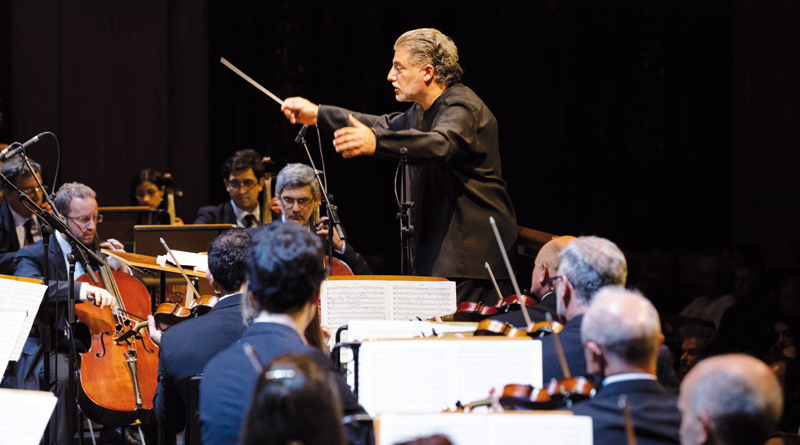

On the shoulders of the current run of ‘Carmen’, The Royal Opera House Muscat mounted a stunning performance of Beethoven’s Ninth Symphony in D minor by the orchestra and chorus of the Teatro Colón Buenos Aires on Friday night. While the opera cast rested their voices, the musicians from the pit were placed centre stage (delightfully backed by a hint of the Bullring set) for an epic presentation, rarely afforded in concert halls worldwide. Even more exceptional was that José Cura changed roles from Don José, lead tenor in ‘Carmen’, to maestro for the evening, conducting the hundred-strong orchestra and ninety choir members for Beethoven’s magnificent 1824 Choral Symphony.
Before the concert, ticket-holders were invited to a talk by Dr. Nasser al Taee, Advisor to the Board of Directors at ROHM on behalf of the Education and Outreach Department, explaining the background to Beethoven’s final, pivotal symphony. It was an illuminating analysis of its musical structure, cyclical use of motives and where the piece fell during the final, retrospective period of the composer’s life. Armed with such insight, the seventy-minute work in four movements was more accessible to, and enjoyed by, a greater number of concert-goers.
It would be fair to say not only was the single performance sold-out, but the auditorium was also packed to the rafters with nary a spare seat to be seen. At lights down it took some minutes for the full complement of musicians, chorus and soloists to file on stage and take their seats. Finally maestro José Cura took his place on the podium accompanied by Leader (Concert Master) Freddy Varela Montero.
The ‘Allegro ma non troppo’ opened with faltering falling fifths, teetering on the brink of ambiguity between minor and major modes. As themes developed, the fine ensemble playing of the Teatro Colón Orchestra became apparent in the unity of the string quality in warm, broad washes of colour, the precise articulation in the tutti sections and huge dynamic contrasts within the first movement alone.
The second movement, ‘Molto Vivace’ was a whirling Scherzo and Trio, immediately familiar and more accessible to listeners, opening in D minor with carefully placed fugal entries from the woodwind. There were some lovely bassoon passages between short timpani bursts, a fine oboe obligato from Rubén Albornoz while the controlled pauses (silent rests) under Cura spoke volumes. The Trio section in D major provided a delightful contrast with trombones at last, before returning to the Scherzo in an astounding thirteen minute movement.
Marked ‘Adagio molto e cantabile’ the third slow movement is a sort of theme and variations using various fluid key signatures between Bb, G and D minor. Before it began, Maestro Cura turned to greet the audience and announced they would tune up, breaking the formal tension in the hall and allowing a little shuffle. The third movement comprised long, sustained bows from the strings, punctuated by woodwind melodies and a haunting clarinet solo from Carlos Céspedes. An unusual horn solo from Gustavo Hermosilla was prominent over some precise pizzicato from the strings. It developed into fierce brass chords and timpani interruptions in a minor mode, all beautifully executed to a now silent auditorium.
The fourth movement is of course ‘the moment everyone had been waiting for’. At 25 minutes’ duration, it towers over the other three movements like a mini symphony in itself. It involved the ninety voices of the Teatro Colón Choir, trained by Chorus Master Miguel Fabian Martínez, and four soloists, providing the extra-musical element of the Ninth from Schiller’s 1785 ‘Ode to Joy’. It represents an anthem for humanity.
The finale opened with double-bass and cello lines, played so imperceptibly it seemed that they grew out of the belly of the stage. Lower string and bassoon melodies caught infectiously by the ensemble gradually built up with trumpet additions. Finally the bass voice of soloist Christian Peregrino boomed across the orchestra with the opening statement of the theme against exquisite woodwind counterpoint. Here was a man hotfooted from his role as Zuniga in ‘Carmen’ on Wednesday, Thursday and the following night! Gradually the other soloists of the evening were heard clearly in the superb acoustics of the Royal Opera House. Tenor Enrique Folger’s performance was passionate and often exposed; Soprano María Belén Rivarola excelled as she soared across orchestra and choir and Guadalupe Barrientos performed the mezzo-soprano line to her usual high standard. Muscat audiences had been treated to very different performances from these four singers in the Opera Galleria just the previous Saturday. Now they were backed by a cast of hundreds. The piccolo, double bassoon, triangle, bass drum and cymbals which had been idle until now, made an appearance in this glorious, triumphant climax. The two main themes were heard in a double fugato episode and with, ‘Tochter aus Elysium’ the concert was brought to a rousing Finale.
As Cura’s baton descended the auditorium erupted into thunderous applause. José Cura leapt all over the stage to hug the soloists, and indicate the various solo musicians of the evening to receive their deserved applause. It was an energetic conclusion to an incredible performance.
Photos by Khalid al Buisaidi
Oman Observer is now on the WhatsApp channel. Click here



